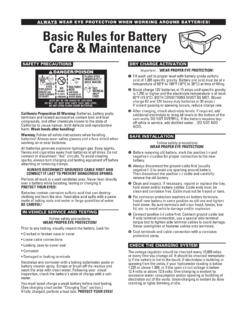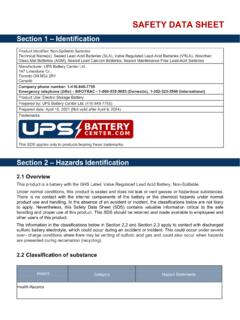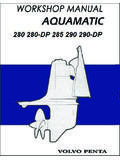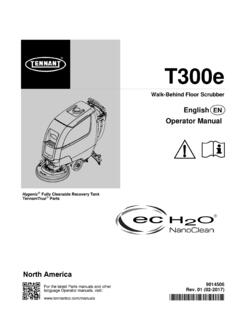Transcription of MATERIAL SAFETY DATA SHEET FOR SEALED LEAD ACID …
1 Copyright 2011 Interstate Battery System International, Inc. MATERIAL SAFETY DATA SHEET FOR SEALED LEAD acid BATTERIES This MSDS applies to all Interstate Batteries and Power Patrol batteries that are SEALED lead- acid batteries including but not limited to those with part numbers starting with SLA and DCM . Revised March 15, 2011 General Information Item Name: Battery, Wet, Non-Spillable Company: Interstate All Battery Company s Address: 1700 Dixon Street Company's city: Des Moines Company's State: IA Company's Country: US Company's Zip code: 50316 Company's Emergency Phone #: 1-800-255-3924 Company's Information Phone #: 1-800-203-6549 Date MSDS First Prepared: May 1, 2009 SAFETY Data Review Date: April 5, 2010 Proprietary: NO Ingredients/Identity Information Ingredient: SULFURIC acid (SARA III) Ingredient Sequence Number: 01 Percent: 32-40 NIOSH (RTECS) Number: WS5600000 CAS Number: 7664-93-9 OSHA PEL: 1 mg/ M3 ACGIH TLV: 1 mg/ M3.
2 9192 Other Recommended Limit: None specified Copyright 2011 Interstate Battery System International, Inc. Proprietary: NO Ingredients/Identity Information (continued) Ingredient: LEAD (BATTERY INTERNALS OF LEAD) (SARA III) Ingredient Sequence Number: 02 Percent: Unknown NIOSH (RTECS) Number: OF7525000 CAS Number: 7439-92-1 OSHA PEL: mg/M3; ACGIH TLV: mg/ M3; DUST 9192 Other Recommended Limit: None specified Physical/Chemical Characteristics Appearance and Odor: Colorless, transparent, no odor (note description of electrolyte, not battery) Boiling Point: 203 F (95 C) Melting Point: Unknown Vapor Pressure (MM Hg/70 F): 10 MM Vapor Density (Air=1): 1 Specific Gravity: Solubility in Water: 100% Corrosion Rate (IPY): Unknown Flash Point: Non-Flammable Lower Explosive Limit: Unknown Upper Explosive Limit: Unknown Fire and Explosion Hazard Data Extinguishing Media: Use water fog, carbon dioxide, foam, or dry chemical.
3 Special Fire Fighting Proc: Wear acid resistant protective equipment and a full faced self contained breathing apparatus. Cool fire exposed containers with water spray. Unusual Fire and Explosion Hazards: When being charged this battery generates hydrogen gas which may form explosive mixtures with air. Electrolyte reacts with water or with metals to release H2. Stability: YES Reactivity Data Condition to Avoid (Stability): Rupture of battery case. Materials to Avoid: Combustibles, organic materials, strong reducing agents, metals, cyanides. Hazardous Decomposition Products: Charging, especially overcharging releases hydrogen, a flammable explosive gas. Hazardous Polymerization Occurrence: None Conditions to Avoid (Polymerization): None Health Hazard Data LD50-LC50 Mixture: Oral Rat LD50 is not known Route of Entry - Inhalation: No Route of Entry - Skin: No Route of Entry - Ingestion: No Health Hazards - Acute and chronic: product contains lead and sulfuric acid .
4 Sulfuric acid is a corrosive causing burns to body tissues. Lead is toxic and some lead compounds are listed as Carcinogenic. Contact with either is highly unlikely to occur unless the case is broken or spilled, and then only contact with the acid is likely. Copyright 2011 Interstate Battery System International, Inc. Carcinogenicity - NTP: Yes Carcinogenicity - IARC: Yes Carcinogenicity - OSHA: No Health Hazard Data (continued) Explanation Carcinogenicity: Lead compounds are listed as carcinogenic in animals and possibly in humans. Signs/Symptoms of Overexposure: Contact with sulfuric acid is the most likely exposure, producing irritation or burns to the body tissue contacted.
5 Med Conditions Aggravated By Exposure: None Emergency/First Aid Proc: First aid is given for sulfuric acid contact. Eyes: Flush w/water 15 min, hold lids open. Skin: Wash with soap & water. Remove contaminated clothing and launder before reuse. Inhalation: Remove to fresh air. Ingested: Do not induce vomiting. Give 2 large glasses of milk or water and get immediate medical care. Give nothing by mouth if unconscious. If irritation persists or is severe, see a doctor. Precautions for safe handling and Use Steps If MATERIAL Released/Spilled: If acid is spilled, neutralize. Place remainder in an acid -resistant container for recycling of the lead. Neutralizing Agent: Sodium Bicarbonate or Lime Waste Disposal Method: Dispose in accordance with all Federal, state and local regulations.
6 HMIS suggests that disposal may be done by flushing neutralized acid to drain and sending remainder to lead reclaimer. Do not incinerate. Precautions- handling /Storing: Store in cool, dry area. Protect from physical damage. Protect terminals from short circuits. Other Precautions: Read manufacturer s literature and follow instructions. Control Measures Respiratory Protection: Respirator will not normally be necessary. Use NIOSH/MSHA approved respirator for acid dust/mist if exposure is above the TLV/PEL. SEE 29 CFR for regulations pertaining to respirator use. Ventilation: Not normally required. Use local exhaust during charging cycles to avoid an explosive build up of hydrogen gas.
7 Protective Gloves: None (rubber if acid is leaking) Eye Protection: SAFETY glasses/splash goggles for liquid Other Protective Equipment: Normal work clothing. Protect with impervious apron and/or boots when handling acid or if acid is leaking. Work Hygienic Practices: Use good industrial hygiene practice. Avoid all contact with acid or internals of the battery. Supplier SAFETY & Health Data: Non-Spillable battery, per CTDF. Transportation Data Review Date: March 15, 2011 Transportation Data Shipping Name: Batteries, Wet, Non-Spillable This battery is not regulated for transportation because it has been tested and passed the tests specified in 49 CFR (a), IATA Packing Instruction 806, and IMDG Special Provision 238.
8 This is to certify that all Interstate Batteries brand and Power Patrol brand SEALED lead- acid batteries are non-spillable batteries as defined by the United States Hazardous Materials Regulations in Title 49 Code of Federal Regulations Part and by the Transport Canada Dangerous Goods Regulations Part (11)(a)(ii)(B). These batteries pass both the Vibration Test and the Pressure Differential Test as found in 49 CFR and they comply with the International Air Transport Association (IATA) Packing Instruction # 806. Copyright 2011 Interstate Battery System International, Inc. According the 49 Code of Federal Regulations : Non-spillable batteries may be transported by air, truck, and boat because they are excepted from the packaging requirements of under the following conditions: (1) Non-spillable batteries must be securely packed in strong outer packagings and meet the requirements of (a).
9 A non-spillable battery which is an integral part of and necessary for the operation of mechanical or electronic equipment must be securely fastened in the battery holder on the equipment; (2) The battery and outer packaging must be plainly and durably marked NON-SPILLABLE or NON-SPILLABLE BATTERY. The requirement to mark the outer package does not apply when the battery is installed in a piece of equipment that is transported unpackaged. Disposal Data Intact, spent batteries are considered to be hazardous waste. Recycling: Battery must be recycled in accordance with all Federal, state and local regulations. Label Required: Yes Technical Review Date: May 22, 1992 MFR Label Number: None Label Status: F Common Name: Lead/ acid Battery Signal Word: DANGER!
10 Acute Health Hazard-Severe: X Contact Hazard-Severe: X Fire Hazard-None: X Reactivity Hazard-None: X Label Data Special Hazard Precautions: First Aid: In case of contact, immediately flush skin with plenty of water. Remove contaminated clothing. Get medical attention. Wash clothing before reuse. Product contains lead and sulfuric acid . Sulfuric acid is a corrosive causing burns to body tissues. Lead is toxic and some lead compounds are listed as carcinogenic. Contact with either is highly unlikely to occur unless the case is broken or spilled, then only contact with the acid is likely. When being charged, this battery generates hydrogen gas which may form explosive mixtures with air.




